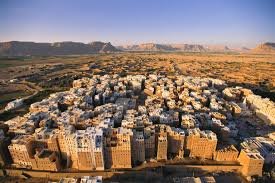Rising from the arid plains of Yemen’s Hadhramaut Valley, the ancient city of Shibam stands as a surreal testament to human ingenuity. Known as the Manhattan of the Desert, this UNESCO World Heritage Site is famed for its towering mud-brick skyscrapers, some soaring over 100 feet high. Yet behind its awe-inspiring facade lies a quieter, more mysterious reality—many of these centuries-old high-rises now stand abandoned, their empty windows gazing silently over the desert like forgotten sentinels.
The Birth of a Mud-Brick Metropolis
Shibam’s origins trace back over 1,700 years, making it one of the oldest vertical cities in the world. Built primarily in the 16th century, its skyscrapers were designed as a fortress against Bedouin raids. The city’s unique urban planning—tightly packed towers within defensive walls—earned it comparisons to Manhattan, though its construction predates modern skyscrapers by centuries. Each building was crafted from sun-dried mud bricks reinforced with straw, a technique perfected over generations to withstand earthquakes and erosion.
The Hidden Engineering Marvels
What few realize is that Shibam’s towers were not just homes but feats of ancient engineering. The walls, sometimes six feet thick at the base, taper upward to reduce weight, while wooden beams act as shock absorbers during tremors. Secret passageways and rooftop escape routes were built into many structures, allowing residents to flee during attacks. Even more astonishing, an underground water channel system—still partially functional—once distributed rainwater collected from rooftops, a lifeline in this parched landscape.
The Golden Age of Trade and Prosperity
At its peak, Shibam was a thriving hub on the incense and spice routes. Wealthy merchants built ornate interiors with carved wooden doors and gypsum decorations, some of which survive today. One lesser-known story tells of a 17th-century trader who smuggled rare Indian sapphires inside hollowed-out mud bricks, hiding his fortune within his home’s walls. The gems were only discovered during a 1990s restoration, long after his lineage had vanished.
The Slow Exodus and Abandonment
Despite its resilience, Shibam’s decline began in the 20th century. Modernization drew younger generations to cities like Sana’a and Aden, while floods in 1982 and 2008 severely damaged the mud-brick structures. Today, nearly a third of the towers stand empty, their original families replaced by squatters or left to decay. In one eerie case, a 400-year-old tower was found with its furniture still intact—tea cups on tables, beds made—as if the occupants had simply vanished overnight.

Ghost Stories and Forgotten Legends
Locals whisper that the abandoned towers are haunted by jinn (spirits) of past residents. One often-repeated tale speaks of a ghostly muezzin whose call to prayer echoes from empty minarets at dawn. Another legend tells of a cursed tower where no family could live for more than a year without meeting misfortune. Whether superstition or oral history, these stories add a spectral allure to Shibam’s silent alleys.
The Fight Against Time and Erosion
Shibam’s greatest enemy is nature itself. Annual monsoon rains erode the mud bricks, requiring constant repairs—a tradition fading as skilled craftsmen dwindle. In 2015, UNESCO added Shibam to its “List of World Heritage in Danger” after a terrorist attack nearby raised fears for its preservation. Yet grassroots efforts persist: artisans still mix mud and straw as their ancestors did, and a handful of families remain, determined to keep their heritage alive.
Modern Explorers and Hidden Treasures
Adventurers and archaeologists continue uncovering Shibam’s secrets. In 2017, a team restoring a collapsed tower found a hidden chamber beneath it, containing Ottoman-era coins and a handwritten Quran. Another explorer documented fading frescoes in an abandoned upper floor, depicting scenes from a lost caravan trade route. These discoveries hint at layers of history still waiting to be revealed.
Shibam’s Uncertain Future
Will the Manhattan of the Desert become a ghost city? Some towers are now stabilized with modern materials, while NGOs train locals in preservation techniques. Yet with Yemen’s ongoing conflict, tourism—once a potential lifeline—has vanished. For now, Shibam stands at a crossroads: a monument to human resilience, slowly being reclaimed by the sands that birthed it.
Visiting Shibam today is like stepping into a living museum, where the past lingers in the cracked mud walls and wind-swept rooftops. Its abandoned skyscrapers are more than ruins—they are silent storytellers of a civilization that dared to build giants from earth and imagination.
Go to main page


